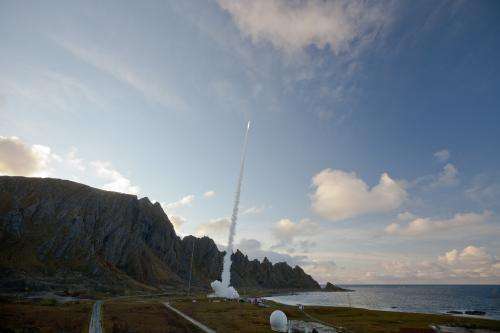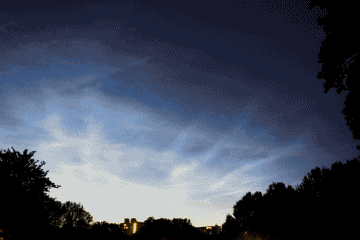Measuring the seeds of noctilucent clouds

(Phys.org) —A constant stream of space debris flows toward Earth from the rest of the solar system. Large meteors can sometimes survive the intense friction and heat upon entering Earth's atmosphere, but by and large the meteors evaporate and reform into tiny particles that are left to whiz through the atmosphere. Such particles are so light and so ubiquitous that scientists refer to them as smoke. Tracking how this smoke swirls around Earth has implications for understanding weather and climate patterns, including – scientists believe – the formation of a polar phenomenon of glowing clouds known as noctilucent clouds.
In October 2011, a NASA-funded sounding rocket traveled up through these ice clouds for a five minute trip to collect some of the first data on just how much smoke exists, what size the particles are, what electrical charge they have, and whether they could indeed form these shimmering clouds as predicted. The Charge and Mass of Meteoric Smoke Particles (CHAMPS) mission showed there was indeed enough smoke – but the data may also require adjustments to the current model.
"The most important aspect of the measurements from CHAMPS is that they can give people confidence," says Scott Robertson who is a space scientist at the University of Colorado in Boulder and the principal investigator for the mission. "The models that tiny meteorite dust lies at the heart of ice crystals in noctilucent clouds are likely right, because there are some 20,000 dust particles per cubic centimeter up there."
These night shining clouds—also known as polar mesospheric clouds, since they occur in a layer of the atmosphere called the mesosphere—were first noticed in 1885, seasonally appearing over the summer poles. Their silvery blue shimmers immediately intrigued tourists and scientists alike, but much of what scientists know about them has been learned only in the last decade, with help from various remote sensing techniques, including instruments on a NASA spacecraft called AIM (Aeronomy of Ice in the Mesosphere). Scientists now know the clouds shine because they're so high they reflect sunlight from over the horizon and their appearance directly relates to occurrences in terrestrial weather in Earth's atmosphere. It is also believed the clouds are made entirely of ice water crystals that have grown on the meteoric dust.

"The smoke particles are transported through the mesosphere toward the poles," says Diego Janches who researches micrometeors for NASA's Goddard Space Flight Center in Greenbelt, Md. "In the summer, the mesosphere over the poles is the coldest place on the planet, so you have very cold temperatures, water vapor and a hard surface in the form of the meteoric smoke. The theory is that ice crystals can form around the hard surface and create noctilucent clouds."
Since 2007, a handful of instruments—rocket-borne instruments, ground based radar and remote sensing via satellite – have loosely confirmed the presence of this dust. CHAMPS, however, was designed to bring back much more precise information about the presence and qualities of the meteoric smoke by directly measuring their qualities.
In October 2011, two CHAMPS rockets launched from the Andoya Rocket Range in northern Norway. One launched during the night on October 11 and one during the day on October 13, to measure how daily ultraviolet light from the sun alters the electrical charge on the smoke. The Andoya site was well suited for this launch since ground based lidar and radar facilities have already carefully mapped out the characteristics of the mesosphere region of the atmosphere there, at heights of 30 to 60 miles up in the sky. Somewhere in the middle of the mesosphere, at about 50 miles up, begins a region of Earth's atmosphere that carries electrons and ions, called the ionosphere, which continues to extend upward to some 600 miles in altitude.
Each CHAMPS rocket flew for a total of just 300 seconds, speeding upward and turning on its instruments after about 110 seconds, at about 35 miles off the ground. The instruments gathered 40 seconds of data until the rocket reached its top height at 60 miles. Then the rocket began its descent for another 40 seconds of data before leaving the mesosphere and continuing downward until it crashed into the ocean. As the rockets flew through space, an onboard detector measured density, size and charge of the particles.
The instruments characterized the meteoric smoke at a level of detail never previously done. At 50 miles in altitude, CHAMPS directly measured 4,000 charged dust particles per cubic centimeter, and the scientists estimate the instruments detected about 20% of the total number of particles. The total number was, therefore, closer to 20,000 per cubic centimeter – making for more than enough to serve as the seeds for the ice crystals in noctilucent clouds.
In other ways, however, the observations didn't match the requirements for the existing model. Each particle was smaller than scientific theories say is needed to form ice crystals. CHAMPS found the particles ranged from 0.4 to 1.2 nanometers in radius. Particles of this size are not believed to have enough surface area for ice crystals to form around them, and so current models require particles with at least a 1.5 nanometer radius. But CHAMPS data also showed that these particles were charged, which can increase the probability that ice will grow on them. The data also showed different amounts of charged particles at different heights and at different times during the day and night. This too must be incorporated into new models of noctilucent cloud formation.
"We've started talking to modelers to discuss the implications of the data," says Robertson. "We want to see what happens to our models of atmospheric chemistry if you put in this many dust particles, with these sizes and charges."
Every improvement to a model increases our understanding of the complex movements and exchanges of energy throughout the atmosphere – not only in terms of conventional terrestrial weather and climate but also in terms of the way the sun affects charge density throughout near-Earth space, an occurrence that is part of the larger space weather system that causes aurora. Combining new information from many instruments and missions will help provide the most robust models of this mysterious region.
The CHAMPS mission is part of NASA's Sounding Rocket Program. Sounding rockets, which are part of a broader Low Cost Access to Space program, carry scientific instruments into space along a parabolic trajectory for flights that are typically 5 to 20 minutes long. For over 40 years the Sounding Rocket Program has provided critical scientific, technical, and educational contributions to the nation's space program and is one of the most robust, versatile, and cost-effective flight programs at NASA.
More information: For more about noctilucent clouds and a NASA mission that studies them, visit: www.nasa.gov/mission_pages/aim/index.html
Provided by NASA



















